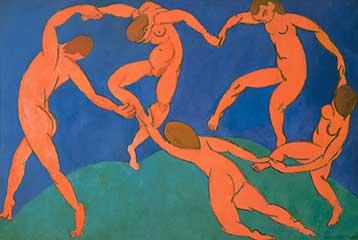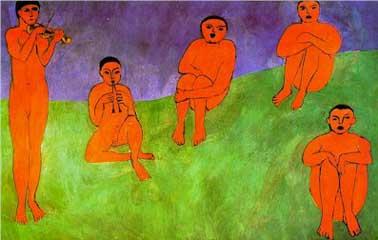Henri Matisse, French Painter by Almas
Moosa

1869 - 1954
"There is nothing more difficult
for a truly creative painter
than to paint a rose, because before he can do so he has first
to forget all the roses that were ever painted."
—Henri Matisse
|
Henri Émile Benoît
Matisse was a French artist, leader of the Fauve group,
regarded as one of the great formative influential figures in
20th-century art, a master of the use of color and form to convey
emotional expression.
Henri Matisse was born at Le Cateau-Cambrésis
in the North of France on December 31, 1869. His parents, Emile
Matisse and Héloise Gérars, had a general store
selling household goods and seed. Henri planned on a legal career,
and in 1887 he studied law in Paris, in 1889 he was employed
as a clerk in a solicitor’s office. It was in 1890 that he was
first attracted to painting. Confined to his bed for nearly
a year (1890) after an intestinal operation, he chose drawing
as a pastime. Then the hobby took best of him and he decided
for the painting career.
The long years of learning followed:
1891 Matisse studied under William-Adolphe
Bouguereau at the Académie Julian, and
in 1892 transferred unofficially to Gustave
Moreau’s studio at the Ecole Beaux-Arts, where
he met Marquet, at the same time attending the Ecole
Nationale des Arts Décoratifs.
|
|
In 1894 his daughter Marguerite
was born, though Matisse did not marry the mother, Amélie
Paraere, till 1898.
In 1896 he made a successful début
at the Salon de la Société Nationale Des Beaux-arts
and a year later displayed there his large canvas La Desserte,
which showed the influence of the Impressionists. After
Moreau’s death in 1898, he studied briefly with Cormon,
then left the Ecole Des Beaux-arts and entered the Académie
Carrière where he met Derain and Puy
and attended evening classes in sculpture. In 1899 his son Jean,
and then, in 1900, his son Pierre were born. Financial difficulties
made him to stay for some time with his parents.
During the period of 1899-1904
Matisse participated in a group exhibition at Berthe Weil’s
Gallery (1902), painted townscapes with Marquet in Paris,
spent the summer of 1904 working with Signac and Cross
at Saint-Tropez, and in 1905-6 painted views of Collioure.
|
| In 1905 and 1906 Matisse, his talent
now fully developed, exhibited at the Salon d’Automne and
the Salon Des Indépendants together with Derain,
Marquet, Vlaminck, Rouault and others and sparked off controversy.
The group was ironically nicknamed "Les Fauves"
(The Wild Ones). At that time Matisse displayed a tendency
towards monumental, decorative compositions. If in 1900 it was
only to earn some money that he took on the task of painting a
frieze for the World Fair at the Grand Palais in Paris,
in 1907 he worked with enthusiasm on a ceramic triptych, Nymph
and Satyr, for Osthaus’s mansion in Hagen, Westphalia.
|
|
 |
 The Dance
(first version)
The Dance
(first version) |
In 1908 Matisse painted the monumental
canvas
The Red Room;
and in 1909-10 executed two large decorative panels,
The Dance and The Music.
|

The Music |
| Matisse set forth the theoretical basis
for his art in his Notes d'un peintre (1908) and expounded
his views on painting in the art school The Atelier Matisse
which was was founded by Hans Purrmann in 1908. Purrmann
organized some influential Matisse exhibits in Germany that the
Expressionists saw. He was born in 1880 in Speyer and studied
in Karlsruhe and Munich. In 1905 he moved to Paris, and was a
pupil and friend of Matisse. In 1919 he became a member of the
Prussian academy of the arts. |
|
In 1910 Matisse visited Munich to see
an exhibition of Islamic art, in 1911 Seville, then Moscow on
the invitation of S. Shchukin, and at the end of that year,
Tangier, Morocco. From 1914 to 1918 he divided his time between
Collioure, Paris and Nice. In 1918 a Matisse-and- Picasso exhibition
opened at the Guillaume
Gallery: it was to a certain extent indicative of the
role of these two painters in contemporary art. |
| In 1920 Matisse designed the stage
sets and costumes for S. Diaghilev’s ballet The Nightingale
(to Stravinsky’s music) and in 1939 for Léonide Massine’s
ballet Rouge et Noir (to the music of Shostakovich’s first
Symphony). In 1931-33 he painted a large decorative composition,
The Dance, for the Barnes Foundation in Merion,
Pennsylvania; the same years he fulfilled etching illustrations
for Mallarmé’s Poésies. |

The Dance, 1932-33. Oil on canvas,
Barnes Foundation, Lincoln University, Merion, PA, USA.
|
|
|
In 1934-35 Matisse produced cartoons for carpets,
based on James Joyce’s Ulysses. During the Second World
War Matisse lived in the south of France – Bordeaux, Ciboure,
Nice. In 1941 he underwent a serious operation. Confined to
bed for most of the ensuing period, he turned his attention
to book design and illustrations.
After surgery in 1941, he remained bedridden for
most of the remainder of his life, but Matisse felt philosophically
reborn. He changed his method of work: instead of painting,
he covered sheets of paper with brilliantly hued gouache. Next,
he cut out shapes with scissors, and pasted the shapes on flat
paper supports. He called the results decoupages or cut-outs.
These cutouts had the wholeness of gesture that most abstract
painting could not reach. At an age when most artists are repeating
themselves, Matisse reentered and redefined the avant-garde.
|

Memory of Oceania, 1953
|
He designed and illustrated Henri de Montherlant’s
Pasiiphaë in 1944, Baudelaire’s Les Fleurs du
Mal, Mariana Alcoforado’s Lettres Portugaises and
Reverdy’s Visages in 1946, and Ronsard’s Amours
in 1948. His unique book Jazz, published in 1947, contained
a facsimile reproduction of the text written in the artist’s
own hand and illustrations executed in gouache after Matisse’s
cutouts
It was only after the end of the war that Matisse
turned anew to monumental compositions. He executed sketches
for the stained-glass panel representing St. Dominique
in the Church at Assy (1948), the interior decoration
for the Dominican Chapel of Notre-Dame du Rosaire at Vence
(1948-51), and sketches for the stained-glass panel Rose
for the Uniate Church in New York (1954). In his
last years he devoted a great deal of his time to cutouts and
brush drawings.
|
The
Musée Matisse was opened
in 1952 at Le Cateau-Cambrésisi,
the birthplace of the artist.
Matisse died on November 3, 1954
and was buried in the cemetery at Cimiez.
|

A self portrait of Matisse |
"When I put a green,
it it not grass. When I put a blue, it is not the sky."
Matisse was painting pictures, not things. Though he was inspired
by what he saw around him, for Matisse the rule was to "interpret
nature and submit it to the spirit of the picture."
|
References:
http://www.norfacad.pvt.k12.va.us/project/matisse/matisse.htm
http://www.arts-studio.com/henri-matisse/index.shtml
http://www.artincontext.com/listings/pages/artist/z/5lcb3hsz/menu.htm
http://www.artchive.com/artchive/M/matisse.html
http://sunsite.dk/cgfa/matisse/matisse_bio.htm
http://www.henrymattisse.com/
http://www.lucidcafe.com/library/95dec/matisse.html
http://www.speyer.de/de/tourist/museen/purrmann
|